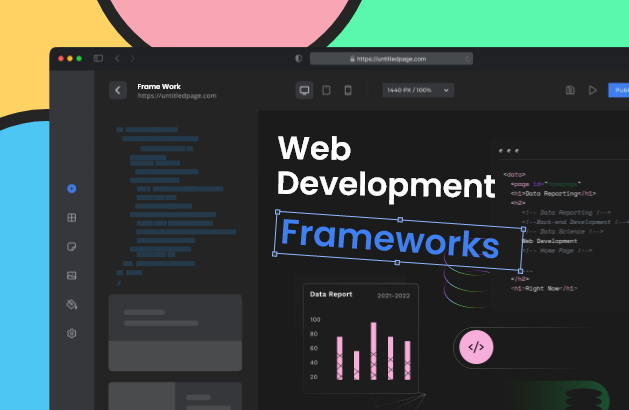Web Development Frameworks

What is essential for the digital success of a business today?
A website? Websites are vital, but it is possible to make decent websites nowadays with no-code platforms. So, what is it? * drum rolls *
The most important factor is the time to market. When you have an idea for a web application or website, it is good if it goes to market as soon as possible. Ideas are cheap and it is the implementation that ensures success. Another fact is that 1 in 4 small businesses still don’t have a website for their business. An empty spot needs to be addressed.
Synonymous to speed in web development are frameworks. Web development frameworks ensure that your website is ready promptly to reach the market. They create conventions, standardize, and make sure default requirements such as layouts, file structure, etc. are in place. This way you don’t have to build every project from the ground up.
As with any good technology, there are multiple options in frameworks as well. Some of these are outlined briefly here.
Top Web Development Frameworks for 2022:
1) Angular
According to Github, Angular (different from AngularJS) is the second most popular web development framework. The framework is backed by a huge community contributing various libraries, controllers, etc. The ecosystem is humungous and it can be utilized effectively to build enterprise-grade web applications and single-page applications.
Angular functions under the Model-View-Controller (MVC) architecture. Therefore, web apps made using it can be optimized capably for SEO. However, there are murmurs in the community that it isn’t entirely SEO friendly. As stated early, since this is a big ecosystem the learning curve is also stretched. But, the biggest advantage is that web apps can be highly customized and maintained relatively easier.
Some companies that use Angular are Google, PayPal, Nike, Upwork, etc.
Framework Link: https://angular.io/
Github Link: https://github.com/angular/angular
2) ReactJS
Like Angular, ReactJS is a front-end framework. Although the development community refers to it as a framework, rightfully reactJS is a library. ReactJS follows a component-based architecture and can develop only the User-Interface or view part of MVC. The additional advantage is that the web apps thus developed can be made into mobile apps utilizing React Native (brother of ReactJS).
But, a framework is not simply the most popular and widely used because of the above reasons. A framework’s got to do more. And ReactJS does so. The swift rendering with virtual DOM, effective code structures, handy developer tools, and easy debugging and fixing make it the best choice. To explain in simpler terms, it is easy to code, easy to load, and easy to maintain apps developed by ReactJS.
Companies like Meta, Tesla, Walmart, etc. utilize ReactJS in their ecosystem.
Framework Link: https://reactjs.org/
Github Link: https://github.com/facebook/react
3) ExpressJS
Minimalism thy name is ExpressJS. It is used for the effective development of the backend and is a part of the NodeJS framework. It utilizes all the functionalities of asynchronous NodeJS without obscuring its features. Simply put it offers most features as plugins. This way it offers high flexibility while staying lightweight. It supports full applications as well as REST APIs, adding to its versatility.
ExpressJS allows for quick development. It has built-in features and functionalities such as routing, templating, server-side scripting, third-party integrations, etc. Without it, your developer might have to spend a lot of time developing an efficient API. Big businesses such as GoDaddy, IBM, Fox Sports, etc. utilize Express in their frameworks.
The biggest drawback, however, comes from the fact that Express is not beginner friendly. One must hold quite the expertise in order to effectively utilize its rich features.
Framework Link: http://expressjs.com/
Github Link: https://github.com/strongloop/express
4) Google Web Toolkit
Google Web Toolkit or cutely known as ‘gwit’ is a software development kit developed by, you guessed right, Google. Google wanted to make developing high-performing web applications simple and accessible. And the result was ‘gwit’. A user doesn’t have to be an expert in JavaScript and other related technologies to use it. The toolkit has Java API libraries, widgets, compiler, development server, and IDE Plugin for easy and streamlined development.
The process is simple. You develop a web application using Java libraries and widgets. Debug the application in IDE or browsers using the developer plugin. The compiler can then be used to optimize the application by splitting it into fragments and performing functions such as in-lining methods, removing dead code, etc. Once ready, everything is compiled and deployed for usage on different browsers and devices.
GWT is used on various google products such as Google AdWords, Google Wallet, etc.
Framework Link: https://www.gwtproject.org/
Github Link: https://github.com/gwtproject
5) Django
Some of the biggest organizations such as NASA, Google, Instagram, Spotify, etc. trust Django with their web application. Django is an open-source framework based on Python that promotes neat design, and swift and scalable development. The core ideology behind Django is reusability and security. And so it was built on Model-View-Template (MVT) architecture, a variation from the MVC architecture.
Django follows Don’t-Repeat-Yourself (DRY) design pattern. A developer using Django simply uses the components stored in the templates for development rather than reinventing the wheel. The templates contain reusable code components, making development rapid and code clean. And Django also forbids code execution in the template layer allowing less space for vulnerabilities.
Additionally, Django comes with packages called ‘batteries included’ which adds more versatility to your web application.
Framework Link: https://www.djangoproject.com/
Github Link: https://github.com/django/django
Closing Thoughts:
When it comes to web development frameworks, there is no right choice. Each framework has its own unique advantages and it all depends on your requirements. Arguably, one of the best features of all frameworks is that your websites are accessible across various devices and screen sizes. Utilizing dynamic code, various classes can be reused, hidden, etc. This ensures a rich user experience and improved engagement.
Moreover, these frameworks are backed by a community of people who help each other. With support from a community and readily available resources, frameworks offer the most efficient development and implementation.
As stated in the beginning, time to market is everything. And web development frameworks could act as the extra pair of hands that can jump-start your projects. Frameworks simplify complicated tasks, helping the developer to focus on core development and delivering a quality output.








